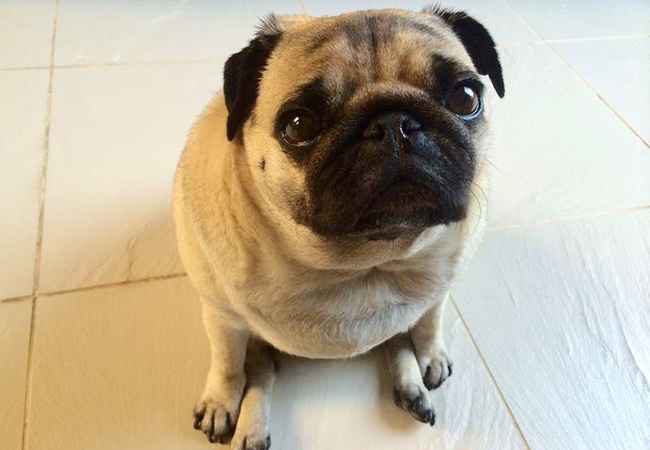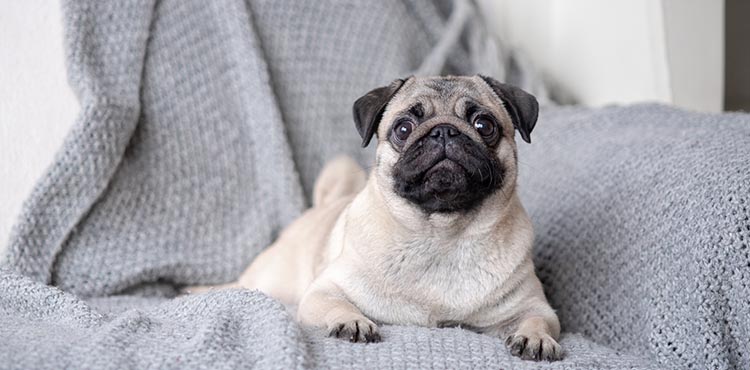The Pug has been around for A. Very. Long. Time.
The recorded history of the Pug dates back about 1000 years to the Song Dynasty in Ancient China before they were introduced in to European royal circles in the 16th century. The clever little fellas have historically had a habit of charming the aristocrats and royals wherever they go and, as a result, have certainly been able to enjoy the finer things in life. Because of this penchant for rubbing shoulders (well noses and stubby little tails) with high society, perhaps it’s no surprise that Pugs have such big personalities for such little people.
Unlike the recently mentioned Scottish Fold Cat (which is derived from a gene mutation and has a very short lineage of only 50 or so years) the Pug’s documented history is a very useful example of the impact of over-breeding (or “aggressive breeding” as some have labeled it).
Pugs are playful, confident and friendly dogs that are now more popular than ever. Their distinctive look, loyal and loving nature and outstanding temperament make them a hugely sought-after companion. However, as one of the most extreme examples of brachycephalic (broad, flat faced/short snout) dogs, Pugs are, however, prone to many health problems and can suffer even more so in the Middle East climate than in others.
The Pug we know and now love has a couple of key physical characteristics – its size (short, robust body) and its very flat face. Whilst the size has been consistent throughout the years, the shortening of the snout has become more and more pronounced in recent times.
The picture (right) shows a typical Pug in portrait at the end of the 19th century with a short but obvious snout.
The flattening of the features since then is largely due to the demand for the almost human facial expressions found in these brachycephalic pooches and the perception of personality that entails.
Bill Lambert, Senior Health and Welfare Manager at the Kennel Club said: “There’s no doubt that Pugs and other popular brachycephalic breeds are suffering due to a huge surge in indiscriminate breeding for certain exaggerated features, like flatter faces, which is driven by fashion and often perceived to look or sound cute.” (Izzy Lyons; 4th August 2019, Daily Telegraph UK/online)
The challenges created by Brachycephalic Obstructive Airways Syndrome (BOAS) can be exaggerated by climate and certainly our hot desert environment is not one that the Pug is naturally adapted to. The Pug’s flat face and therefore reduced airway, breathing and respiration can become difficult and labored. Sadly, the sounds of snuffling and audible breathing (and snoring) can be indicators of breathing difficulties, the very traits which can enhance the dog’s cuteness can also become a serious cause of discomfort and, in some cases, major health issues.
In addition, the severely changed facial features of brachycephalic breeds can mean that inter-dog communication becomes more challenging due to the difficulty for other dogs to recognize facial expressions. This may lead to miscommunication within the species and may result in confrontation and even fights.
Pugs also regularly suffer from skin and eye infections and irritations due to their scrunched up, wrinkly little faces and prominent, almost bulbous eyeballs.
 The list of common ailments for the Pug include the above mentioned as well as:
The list of common ailments for the Pug include the above mentioned as well as:
Hip dysplasia, elongated palates (which exacerbate breathing problems and “snoring”), patellar luxation (movement and displacement of the kneecap and resulting lameness), entropion (inwardly turning eyelids), kerato-conjunctivitis (eye infections), obesity and skin issues.
However, despite all these challenges, the Pug as a breed remains a bouncy, friendly, sociable dog who loves to be loved and reciprocates tenfold… they are adorable pets and, with a clear understanding of their challenges, can live long and very happy lives.
Read on for Dr Vito’s top tips to support your Pug to lead a long and happy life:
- Pugs are often very energetic and you’ll need to recognise this by keeping your Pug active, both physically and mentally. However, too much exertion in either duration or intensity can lead to breathing difficulties or overheating for this brachycephalic breed.
- Ideally exercise should be on a regular basis whilst keeping in mind your dog’s limitations. Consider walking your Pug on a harness, not a lead to avoid any potential impact on breathing.
- Pugs are prone to obesity and this directly worsens any respiratory stress. Thus, a healthy but calorie restricted diet is key. Limit treats and instead use toys as rewards. Puzzle feeders are great ways to keep Pugs busy!
- In extreme cases, the structure of a Pug’s jaw may make eating difficult. Ask about the Pug specific foods that are available.
- Palate Reduction Surgery may be something that Pugs can benefit from to ease breathing and enable better oxygenation of the body (and Dr Vito happens to be highly skilled and experienced in this specialist procedure).
- Pugs are prone to skin yeast infections, eye issues and heavy shedding, so this a breed that requires lots of grooming and maintenance.
- Pugs’ eyes are large and slightly bulging which means they are prone to picking up debris that can irritate the eyes or scratch the cornea. Keep the eye area clean by wiping it at least once a day or apply lubricating eye drops.
- The deep wrinkles on their head and face make these areas prone to infection. Paying close attention to keeping these areas clean and dry is important. Using something gentle such as Earthbath® grooming wipes are a great way to do this.

Of course, a regular visit to the Vet is crucial to support a positive health plan for your pet (whatever species and breed) and Pugs will definitely benefit from a proactive approach by their pet parents. Weight checks with the GVC nursing team, regular grooming and a refreshing of toys and (non-food) treats will all be highly appreciated by your Pug as part of a preventative health- and wellbeing plan.
Please call 02 556 2024 or email info@germanvet.ae to make an appointment and learn more.
